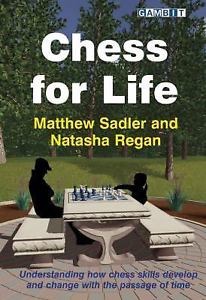Chess for Life
Matthew Sadler, Natasha Regan

Chess for Life, by a well-known Grandmaster and a Womens International Master with a strong background in statistics and gaming, has plenty to say about how veteran players can use their experience to compensate for a loss in youthful energy.
The two authors have interviewed a number of Grandmasters and strong amateurs to gain insights into how they have been able to still play at a high level into their forties, fifties and beyond. Among those sharing their wisdom are John Nunn, Yasser Seirawan, Nigel Short and Judit Polgar. While they have plenty of advice to offer the chapters on Sergei Tiviakov and Keith Arkell might be more useful for mortals.
The former is a former Candidate (PCA Cycle 1994) who at his peak was around 2700 FIDE in 2005. A decade later, age 43 and competing against players half his age, he has dropped a hundred rating points but still competes successfully in open tournaments.
Arkell, a little over a decade older (age 55), and also rated about a hundred points from his peak (2448 June 2016, 2545 July 1996), shares several things in common with Tiviakov besides a slow decline. First both specialize in openings that lead to middlegames that suit their style. The openings are not particularly sharp or theoretical, but the two players have a wealth of experience with them.
Second, and possibly more important, both players not only have excellent endgame technique, but the patience and motivation to grind down their opponents.
Numerous examples of Arkells prowess in rook and pawn endgames is given including the following example, played before either player earned their Grandmaster title.
Keith Arkell- John Emms, Nottingham 1987
1.d4 Nf6 2.Nf3 b6 3.c4 e6 4.g3 Ba6 5.b3 Bb7 6.Bg2 Bb4+ 7.Bd2 a5 8.0-0 0-0 9.Bf4 a4 10.bxa4 d6 11.Qb3 Na6 12.a3 Ba5 13.Nc3 Bxc3 14.Qxc3 Nb8 15.Bg5 Nbd7 16.Qd2 Bc6 17.Ne1 Bxa4 18.Qb2 Ra5 19.Bd2 Ra7 20.Nd3 c5 21.Rfb1 Qc7 22.Bg5 cxd4 23.Bxf6 Nxf6 24.Qxd4 Nd7 25.Rb2 Rc8 26.Rd2 Bc6 27.Bxc6 Qxc6 28.Nb2 d5 29.cxd5 exd5 30.Qxd5 Qxd5 31.Rxd5 Rc2 32.Rad1 Nf8 33.Rb5 Rxa3 34.Rd8 Ra2 35.Nd3 g6 36.Rxb6 Kg7 37.Nf4 Rab2 38.Rxb2 Rxb2 39.h4 h5 40.Re8 Rb7 41.Kg2 Nh7 42.Ra8 Nf6 43.f3 Ng8 44.Nd5 Nf6 45.Nf4 Ng8 46.Kf2 Nh6 47.e4 Rb2+ 48.Ke3 Rb7 49.Ra3 Ng8 50.Nd3 Nf6 51.Nc5 Rb5 52.Nd3 Rb7 53.Ne5 Nd7 54.Nc6 Rc7 55.Nb4 Rb7 56.Nd5 Rb1 57.Rc3 Rd1 58.Nf4 Rb1 59.Nd3 Rb7 60.Kd4 Nf8 61.Ra3 Nd7 62.e5 Nf8 63.Ke4 Ne6 64.Rc3 Ra7 65.Rc4 Kh7 66.Rb4 Rc7 67.Nf4 Nxf4 68.gxf4!
Why take with the pawn and not the king? The authors explain:
“White has retained the possibility of creating a passed e-pawn with f5 and e6 while the f-pawn hides the white king from checks from the rear. This makes an invasion by Whites king into the black position more likely. White can also attack Blacks h-pawn with Kg5 more effectively as he also defends both the f-and h-pawns from this square.
68… Rc1 69.f5 Rh1 70.Rb7 Kg8 71.Rb8+ Kh7 72.f6 Rxh4+ 73.Ke3 Rh1 74.Rf8 h4 75.Rxf7+ Kh8 76.Re7 h3 77.Re8+ Kh7 78.f7 Re1+ 79.Kf4 g5+ 80.Kg3 Rg1+ 81.Kxh3, 1-0.
Another interesting chapter in the book is on the late Tony Miles. The top English player of the 1970s and early 1980s, Miles had a justly deserved reputation as a practical player who was a strong fighter. Unlike Tiviakov and Arkell, he was more adventurous in the openings and Sadlers dissection of his repertoire makes for fascinating reading. Tony was a great expert in the English Defense (1.d4 e6 2.c4 b6) and also dabbled with 1.d4 e6 2.c4 Bb4+. Both gave him the opportunity to leave the highway and venture off into uncharted territory. Unfortunately the problem for Tony was 1.d4 e6 2.e4. as he did not like to play the French. He played the Paulsen Sicilian for a while and had success with 1.d4 e6 2.e4 b6, but the former didnt suit his style and he suffered some nasty losses with the latter. In the pre-computer days Miles chose to play 1.d4 e6 only when he was confident his opponent would not play 2.e4, but he couldnt always be sure!
Chess for Life is a book that can be read with interest by many players (not only those over 40!) for those rated 2000 on up.
